#invoke the 14th
Explore tagged Tumblr posts
Text








Verify the vote. Invoke the 14th. Follow us on Bluesky.
#us politics#us election#election 2024#14thNow#beat the cheat#cheater in chief#verify the vote#invoke the 14th#election truth alliance#more coming soon#with a focus on data analysis
25 notes
·
View notes
Text
The Anatomy Of Baphomet

Baphomet is one of the most complex and misunderstood figures in occult and esoteric history. Over centuries, it has evolved from a mysterious name whispered during the Crusades to a symbol deeply embedded in modern occultism, especially within Satanism, Thelema, and Left-Hand Path traditions.
History Of Baphomet
Origins in the Templar Trials (14th Century):
• The earliest known use of the name Baphomet was during the Inquisition of the Knights Templar in 1307.
• The Templars were accused of heresy and idolatry, including worship of an idol called "Baphomet". The exact nature of this idol remains unclear—some described it as a human head, a bearded man, or a demon.
• Most modern historians believe the name Baphomet may have been a corruption of Mahomet (an old form of Muhammad), reflecting the Crusaders' exposure to Islam.

19th Century Revival; Eliphas Lévi:
• In 1856, Éliphas Lévi, a French occultist, radically redefined Baphomet in his book Dogme et Rituel de la Haute Magie.
• Lévi depicted Baphomet as a winged hermaphroditic figure with the head of a goat, a torch between the horns, female breasts and androgynous features, one arm pointing up and one down, with the words Solve (dissolve) and Coagula (combine) on each forearm. This became the iconic image associated with Baphomet today and symbolized the unity of opposites: light and dark, male and female, human and beast, matter and spirit.
20th Century and Beyond (Satanism and the Occult):
• The Church of Satan, founded by Anton LaVey in 1966, adopted Baphomet as a symbol of Satanic philosophy—not as a literal being, but as a representation of rebellion, knowledge, and liberation from religious dogma.
• The Sigil of Baphomet—a goat’s head within an inverted pentagram surrounded by Hebrew letters spelling “Leviathan”—became the official insignia of the Church.

Symbolism Of Baphomet
Baphomet represents balance and integration of opposites. It is a philosophical and alchemical emblem rather than a deity to be worshipped.
Key Symbolic Elements:
• Goat Head- Instinct, primal nature, and untamed energy (possibly derived from the god Pan).
• Torch Between Horns- Divine illumination; the light of intellect and truth.
• Androgyny (Breasts and Caduceus Phallus)- Union of male and female, symbolizing wholeness.
• Wings and Hooves- Duality of spiritual ascent and earthly grounding.
• Arms Pointing Up and Down- The Hermetic axiom “As above, so below”, expressing the correspondence between planes.
• Solve et Coagula- Alchemical principle of breaking down and reforming—transformation and enlightenment.
Baphomet In Magick And Occult Practice
Baphomet is not commonly invoked as a deity but is used as a symbol of occult mastery, personal transformation, and spiritual rebellion.
In Thelema (Aleister Crowley’s System):
• Crowley saw Baphomet as a mystical androgen, a symbol of spiritual initiation and the reconciler of opposites.
• He took the name “Baphomet” as a magical name when he became head of the O.T.O. (Ordo Templi Orientis), aligning it with sexual magick and Gnostic symbolism.

In Satanism (LaVeyan, Theological, Etc.):
• Baphomet is used as a symbol of rational self-interest, rejection of traditional religious authority, and the embrace of carnal existence.
• The Sigil of Baphomet is used in rituals, meditations, and symbolic expressions of personal empowerment.
In Witchcraft and Modern Paganism:
Some non-theistic witches or Left-Hand Path practitioners view Baphomet as:
• An archetype of sacred balance
• A symbol of hidden knowledge
• A guardian of the threshold—facing and integrating one’s shadow
Magickal Uses Of Baphomet
Rituals and Practices:
• Invocation or Meditation- To balance opposing forces within oneself—gender, emotion and reason, higher and lower self.
• Shadow Work- Baphomet can be invoked as a symbol during introspective work, especially when dealing with repressed desires or fears.
• Alchemy and Transformation- In rituals seeking internal transformation, Baphomet represents the alchemical process of spiritual rebirth.
• Sigil Magick- The Sigil of Baphomet is used for protection, empowerment, and banishing fear or dogma.
Altars and Tools:
• Practitioners may use statues, medallions, or artwork of Baphomet to create a liminal sacred space, serve as a focal point for meditation, and represent the divine within and without—a mirror for the seeker.
The Nature Of Baphomet
Baphomet is not a devil, not a god, and not a literal being—it is a metaphysical symbol. Its purpose is to challenge, to enlighten, and to reveal the wholeness hidden in duality. Baphomet asks the seeker to transcend dogma, embrace the totality of existence, and find spiritual freedom through inner synthesis.

#baphomet#symbology#anatomy#lefthandpath#satanic witch#witchcraft#magick#witch#dark#satanism#witchblr#demons#demonolatry#anton lavey#aleister crowley#occult#occult art#esoteric#eclectic witch#eclectic#pagan#alchemy#balance#duality#goat#nature#demon#idol#demonology#history
214 notes
·
View notes
Text
So, Wizarding Robes
I saw this post by @iamnmbr3 and @kittenjammer talking about wizarding fashion and I wanted to talk about this for a while, so I'm going to give my own two cents on it based on fashion history. I love history in general, but fashion history and historical architecture are two I’m incredibly passionate about. So, here we go (post with a lot of pictures ahead):
When I read the books and they mentioned unisex “robes” which function like dresses in a way (as you don’t have to be wearing trousers beneath them:
James whirled about; a second flash of light later, Snape was hanging upside down in the air, his robes falling over his head to reveal skinny, pallid legs and a pair of graying underpants.
(OotP, 647)
And described as being very colorful and billowing, often accompanied by a pointed wizard hat, it was clear to me JKR was trying to invoke the image of the classic fantasy wizard robe:

Especially when it comes to Dumbledore.
The thing is, this style is based on a real historical period and historical styles of the medieval period in Europe.
Medieval Europian Robes
When I'm thinking about the "classic fantasy wizard look" the first historical period that comes to my mind is the 15th century and I'll illustrate why.
Spesificly, the 14th and 15th centuries houppelande. It was a long over garment that looked kinda like a dress with wide, flaring sleeves available for both men and women in various shapes, cuts, and even patterns. Here are examples of some houppelandes:
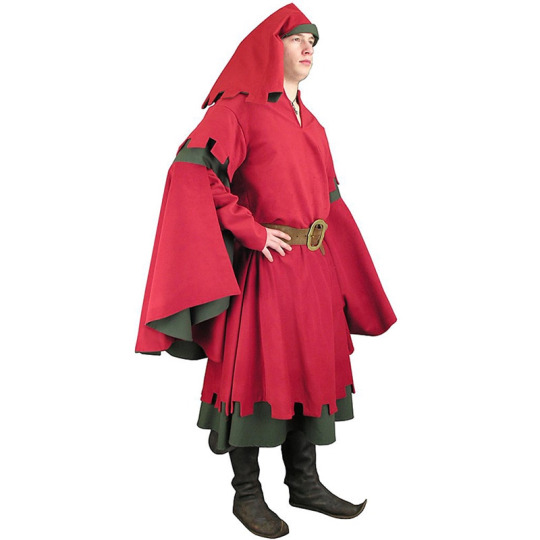
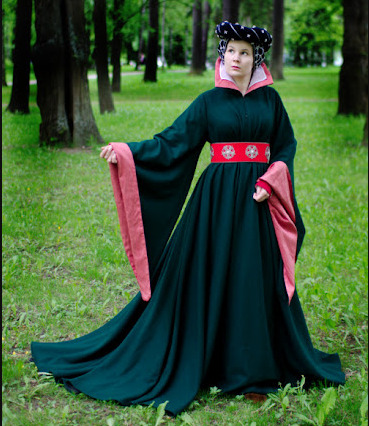

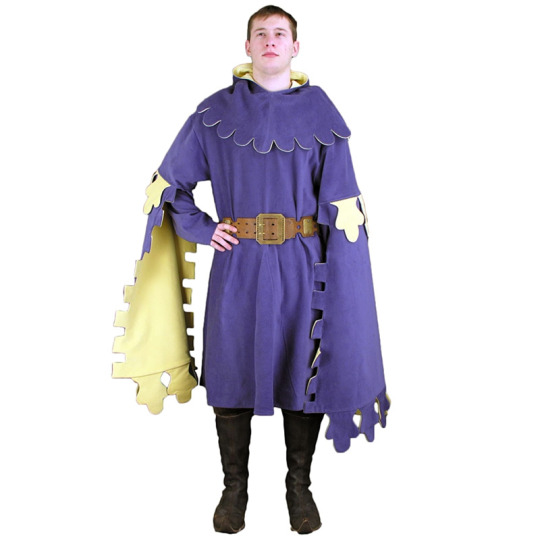

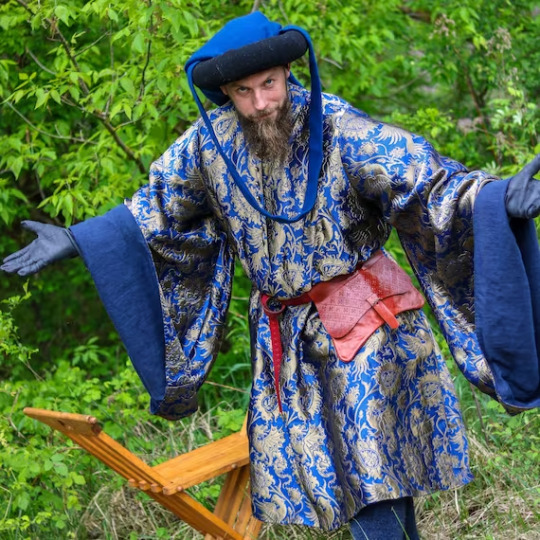
(As you can also see, early 15th-century fashion comes built-in with silly hats! Just like wizards)
In the 15th century you also have a wide array of cuts of cloaks (and even more silly hats!):
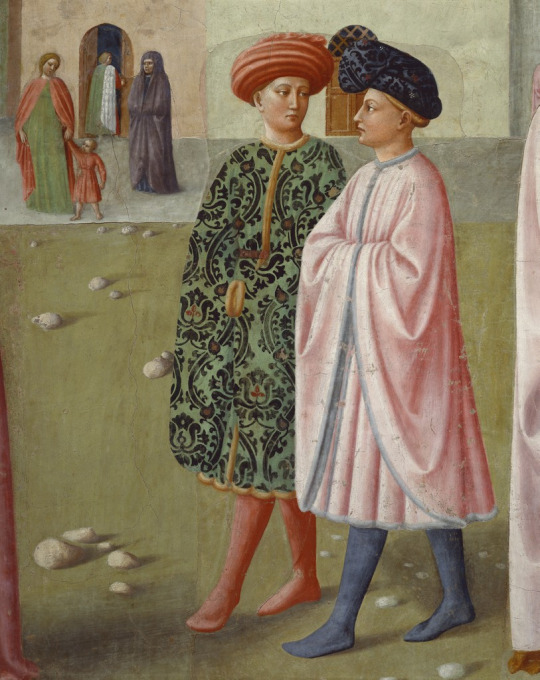
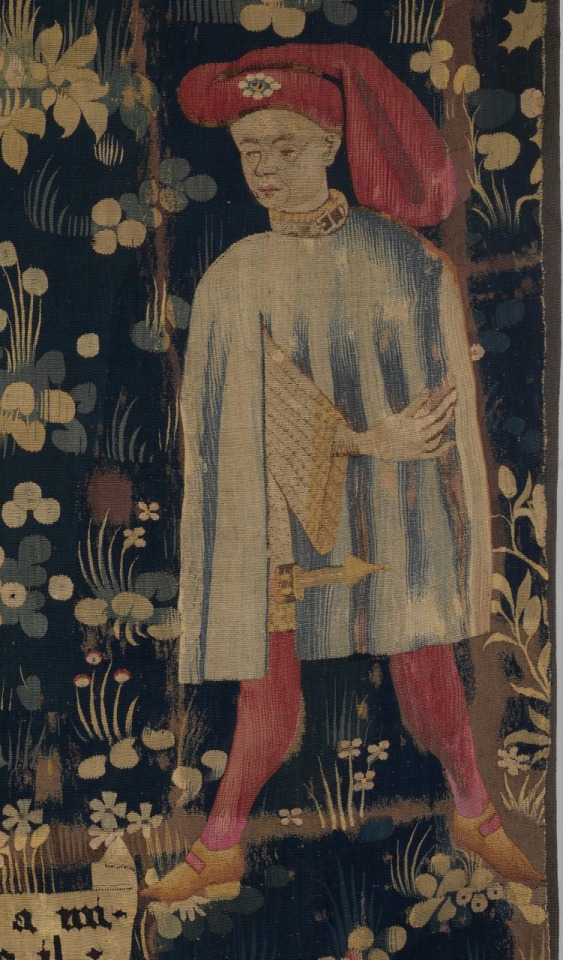
Along with surcoats, that contrary to their name, weren't just for knights to signify on their armor the house they serve:
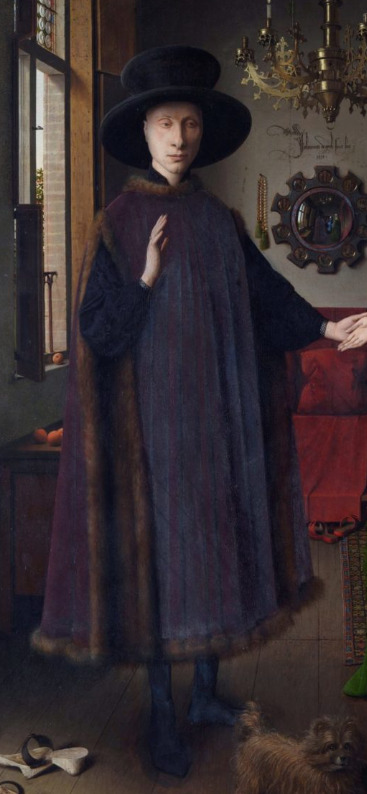
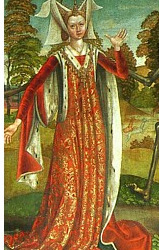
These 15th-century garments are exactly like wizard fashion is described in the books: billowing robes, colorful and eye-catching, and accompanied by silly hats.
The thing is, all these garments are from the high medieval period and as wizards broke away from muggles only when the Statute of Secrecy was enacted, I'd expect their fashion to follow the muggle trend up to that point and then start diverging. Even the most pure-blooded wizarding families of the modern day, like the Malfoys, integrated with muggle circles up until the Statue of Secrecy, something that would've forced them to dress like the muggles at the time to blend in better.
As the Status of Secrecy was first enacted in 1692, it's time to talk about:
Late 17th Century Fashion
Now, while the high middle ages in Europe had everyone wearing essentially wizard robes and silly hats on the regular, the Statue of Secrecy was enacted much later. Fashion in the 17th century was drastically different from the earlier one mentioned above.
In the late 17th century, this is the kind of dress I'd expect from women in England:
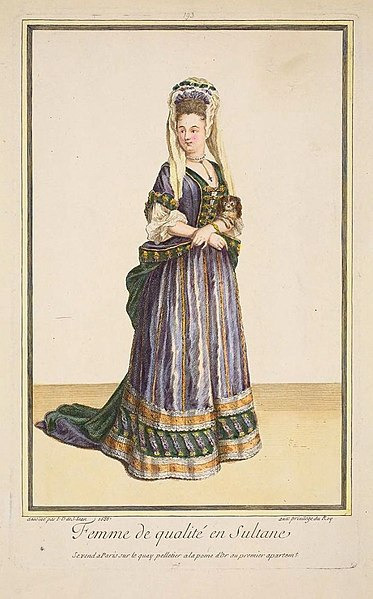
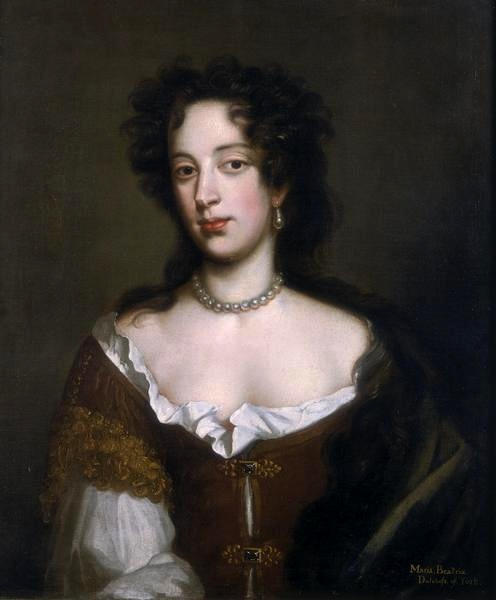
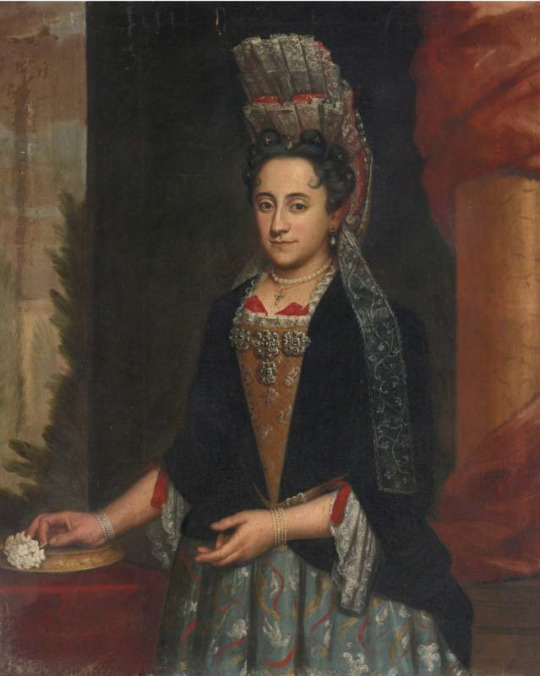

And this is what I'd expect from men:


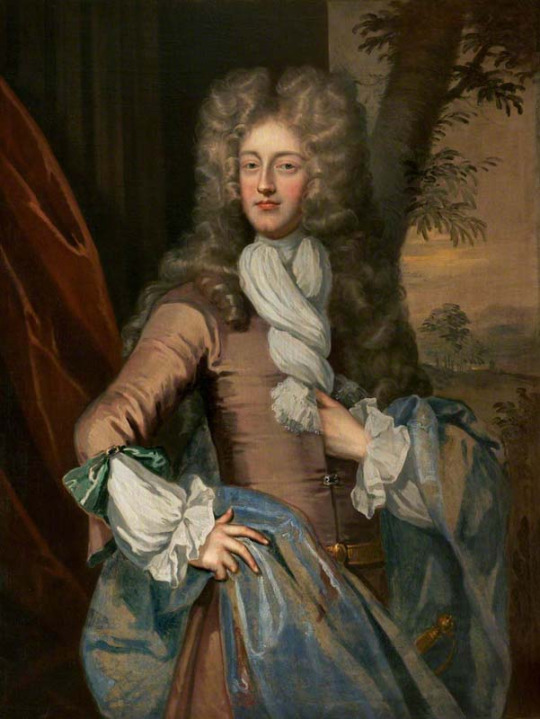
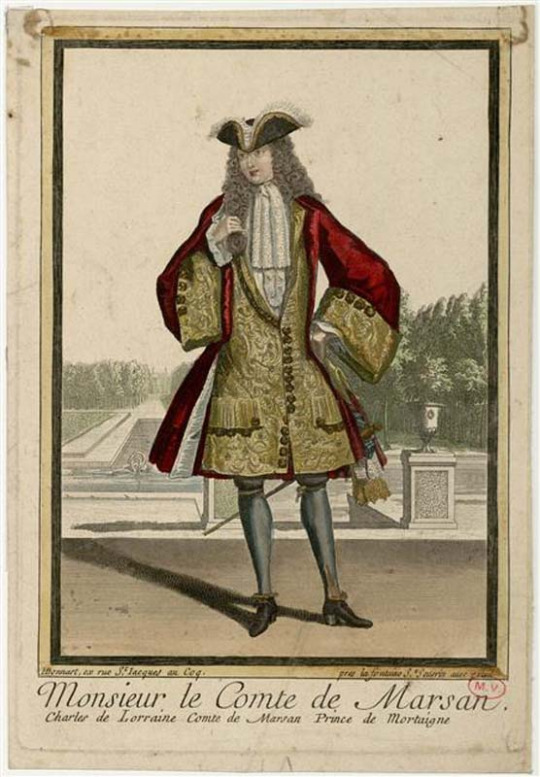
Which is very different from what is described but would've been the historical basis the wizards would work from.
So what do I think wizarding fashion is actually like?
Well, since the books are in the 1990s and wizards don't really live in a vacuum we know some later influences in fashion did make it in. So, I think wizarding fashion is an odd mix of 15th-century and late 17th-century fashions updated to the time period the wizard grew up in, hence distinct fashion changes between generations like we see in the muggle world.
We see these distinct generational fashion changes with characters like Agusta Longbottom who wears a Vulture hat. These sorts of hats with real birds on them were a thing historically. They were quite fashionable in the late Victorian era, which is when Agusta would've been a child if she's around Dumbledore's age:
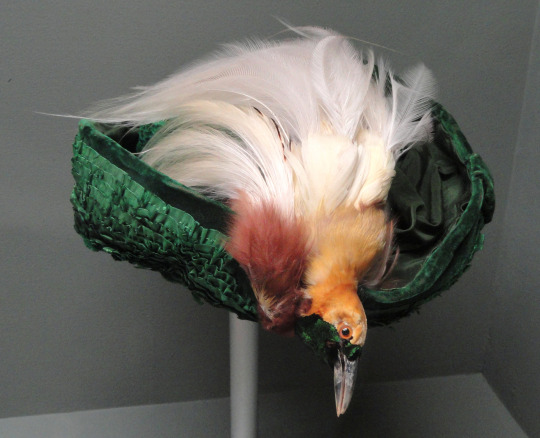
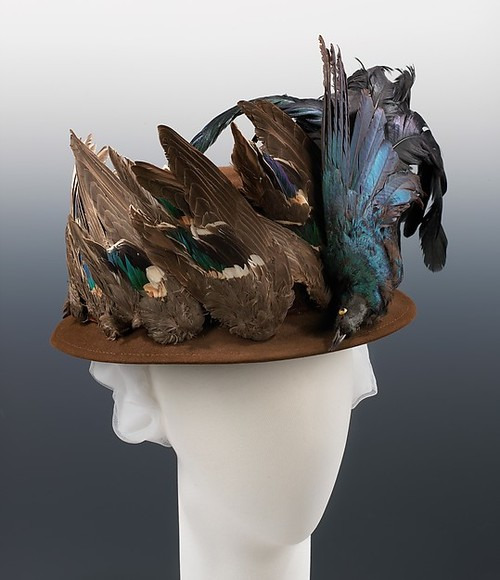
Fudge is described as wearing a Bowler Hat, a kind of hat that started catching on in the late 19th century but was still a staple in menswear into the early 20th century, hence indicating Fudge's age.
Ron's yule ball dress robes are described as old-fashioned, again indicating fashions in the wizarding world change at a similar rate to the muggle one. Note that since the 17th century, fashion has been changing quite rapidly and by the 18th century fast fashion where you need to buy new garments each "season" has already started becoming a thing. With all that, I think wizard fashion indeed changes just as rapidly as the muggle one.
Now, that's great, and all, but, what would that odd mish-mash fashion even look like?
Well, I made a few very quick sketches as concept examples for what casual wizarding fashion in the UK might look like if we're working off historical references:
(not my best pieces, it's just to get the concept across)



Note that Wizengamot robes and other formal professional wear would probably be older in style and closer to 17th-century fashions.
#harry potter#hp#harry potter thoughts#wizarding world#hp meta#hp headcanon#wizarding fashion#wizarding society#harry potter meta#harry potter headcanon#hollowedtheory#hollowedheadcanon#hollowedart#hollowed hp redesign
537 notes
·
View notes
Text

Sardonyx cameo by an unknown Byzantine artist of the 14th century, depicting St. Theodore Stratelates ("Army Commander"). Theodore (281-319) was a Roman soldier, said to have been martyred during the persecution of Christians by the emperor Licinius. Here, Theodore is shown in full military dress, a spear in his right hand and a round shield on his left shoulder. The accompanying inscription invokes him and his namesake, Theodore "the Recruit," as protectors; the cameo would likely have been suspended from a chain and wore around the neck as a protective amulet.
Now in the Walters Art Museum, Baltimore. Photo credit: Walters Art Museum.
#art#art history#Byzantine#Byzantine Empire#Byzantine art#Byzantium#medieval#medieval art#Middle Ages#Eastern Orthodox#Orthodox Christianity#jewelry#jewellery#cameo#sardonyx#Walters Art Museum
273 notes
·
View notes
Text
#where is the line how do you determine who is a “little power” and who is basically a god#who is the standard#bc the average person the average town has nothing against the average 14th level adventurer lol via @veththeebrave I wanted to make this post because just to demonstrate, Keyleth is obviously not as limitless as the gods, but when you stack her up against a commoner it's...remarkably not dissimilar:
A commoner has stats of 10 across the board, 1d8 HP (4 or 5 on average), and an AC of 10. (source)
Keyleth has 147 HP (well over 10x theirs). Her DC is 21 and her spell attack bonus is +12, and she has the cantrip Thorn Whip which deals 4d6 damage, or on average, 14 damage. Unless she rolls a natural 1 she hits, and on average she would perma-kill a commoner. This is not counting her 22 spell slots of various levels, all of which could kill the average commoner. She could cast Storm of Vengeance, wildshape indefinitely while maintaining concentration, and quite reasonably level an entire town and kill every commoner within it while still having almost all of her daily power intact. She is also going to live to be 1800 years old, and is a political leader.
Do we kill Keyleth? Hell, do we kill Ashton, who has nearly as much HP as Keyleth and will surpass her within 2 levels max, 1 if Taliesin rolls well, can resist unconsciousness, can invoke the power of a titan for a minute, and also with a +11 with their hammer hits any commoner unless they roll a nat 1 and at minimum knocks them unconscious (+2 from the hammer, +4 from strength, minimum 2 damage as it's a 2d6 weapon) with even the lightest deliberate attack?
What is your power threshold that is inherently unfair, and at what level is killing everyone of this threshold the solution?
#cr spoilers#like. the core concept of D&D PCs is that you are an extraordinary person (standard array stats are WAY better than commoner stats)#and you increase in power. if you are a d&d pc you are already privileged/naturally gifted in ways most people never will be.
226 notes
·
View notes
Text
Jennifer Rubin at The Contrarian:
For several years, whenever Hillary Clinton appeared for an interview or commented on events on which she had particular expertise, she was greeted with howls from the punditocracy to essentially shut up and go away. Granted, she has been on the national stage since the 1990s, but frankly, Americans could have used more of her insight and advice on the deeds and misdeeds of President Trump over the years. Now, less than a week into the Trump orgy of unconstitutional power grabs, preposterous declarations (renaming the Gulf of Mexico might be the stupidest of the bunch) and the release of the Jan. 6 felons (some of whom were convicted of violent crimes), I sure would like to hear the voice of the other woman nominated to run for president. Many of us would welcome the clear, compelling voice of former Vice President Kamala Harris.
Democracy defenders anticipated that Democrats might be caught on their back feet, but when the Senate minority leader issues anodyne declarations so utterly inapt in the current climate, it’s time to look for a single charismatic voice, one well-versed in law and unafraid to trim her sails. (Sen. Chuck Schumer’s statement after a deeply dishonest, dark, dangerous inaugural address suggested he had not been listening closely: “It’s now time to look to the future. The challenges that face America are many and great. The Senate must respond with resolve, bipartisanship, and fidelity to the working and middle class of this country.”) Trump has launched a full-out assault on the Constitution and the rule of law. His gambits include: attempting to excise birthright citizenship from the 14th Amendment; undermining professional, competent governance with “Schedule F”; and—frighteningly—to move to militarize the border, invoke emergency powers, and grab the Alien & Sedition Act out of the 18th century. (As Ilya Somin explained about the latter, “[T]he Alien Enemies Act cannot be used in our current situation because we are not in a ‘declared war’ with any foreign nation, and there also is no ‘invasion’ or predatory incursion is perpetrated, attempted, or threatened against the territory of the United States by any foreign nation or government.’”)
Harris was the last administration’s most compelling advocate on a range of legal and public-safety issues, from the reversal of Roe v. Wade to the dangers of untrammeled executive power to anti-immigrant incitement. She showed Democrats how to be tough on the border without being cruel, reckless, and contemptuous of the Constitution. (At the Ellipse speech just before the election, she declared, “When I was attorney general of a border state, I saw the chaos and violence caused by transnational criminal organizations that I took on and when I am President, we will quickly remove those who arrive here unlawfully, prosecute the cartels and give border patrol the support they so desperately need.” However, she consistently reminded us we are a nation of immigrants.) She never minced words about Trump’s dictatorial ambitions. She did warn us less than two weeks before the election, “Donald Trump vowed to be a dictator on day one. He vowed to use the military to carry out personal and political vendettas. His former chief of staff said he wanted generals like Hitler’s. Trump wants unchecked power.” Given that she is a former prosecutor who boasted that she put violent criminals behind bars, I certainly would like to hear what she has to say about letting out of prison 1500 people convicted in association with the Jan. 6 insurrection (which resulted in the death of several police officers and serious injuries and trauma to scores of others).
[...] She was right about what Trump intended to do and the danger he posed to the rule of law. She was right about the Supreme Court. Though she certainly deserves a break, whenever she is prepared, given our political vacuum, no one is better positioned to summon democracy defenders to stand up to a lawless president than Kamala Harris.
Jennifer Rubin wrote in The Contrarian on why Kamala Harris should take her perch being the voice for the rule of law calling out Felon 47’s dictatorship.
America will regret picking the Constitution-pissing felon over the prosecutor.
68 notes
·
View notes
Text

The Fourteen Holy Helpers
Feast Day: August 8
The Fourteen Holy Helpers are fourteen saints that are collectively invoked against various ailments and dangers. Devotion to the Fourteen Holy Helpers began in 14th-century Germany, which was suffering from the bubonic plague.
Pictured from top left to right: St. Blase, St. Eustachius (Eustace), St. Achatius, St. Barbara, St. Dionysius (Denis), St. Catherine of Alexandria, St. Aegidius (Giles), St. Margaret of Antioch, St. Pantaleon, St. Christopher, St. Cyriacus, St. George, St. Vitus (Guy), St. Erasmus (Elmo).
Prints, plaques & holy cards available for purchase here: (website)
99 notes
·
View notes
Text

Posted: 2/11/25
The Enchanting History of Love Magic Across Cultures
February has arrived with its whisper of roses, chocolates, and declarations of affection, the air is charged with the promises of love. Valentine's Day (Feb. 14th), though modern in its commercial veneer, is steeped in traditions that reach deep into human history. Among these, the practice of love magic—rituals, spells, and charms to attract, secure, or mend love—has traversed cultures, continents, and centuries. Let us embark on a journey to uncover how African, the African diaspora, Indigenous American, Asian, and European traditions have woven love magic into the tapestry of their spiritual and cultural practices.
Africa: Love and Spiritual Power Intertwined
In many African cultures, love magic reflects the profound connection between the spiritual and the mundane. Among the Yoruba people of Nigeria, practitioners of Ifá divination often called upon the Orisha Osun (Oshun) for love, beauty, and fertility. Offerings of honey, cowrie shells, and fresh water were made to Osun to invoke her blessings for harmonious relationships or to rekindle fading passion.

Meanwhile, across the continent, the use of botanicals for love magic was also widespread. In South Africa, for example, Sangomas (traditional healers) used herbs like "Umavumbuka" to foster reconciliation, harmony and emotional healing. These rituals often reflected the belief that love and harmony within relationships were essential for community balance, weaving personal desire into collective well-being.
African Diaspora: Love Magic in Survival and Resistance
As the African diaspora spread through the transatlantic middle passage, love magic was adapted and evolved within the crucible of multiple new environments. In the Americas, Hoodoo—an African American spiritual tradition—emerged, integrating African, Indigenous, Jewish and European influences. Practitioners used "mojo bags" filled with herbs, roots like John the Conqueror or Queen Elizabeth root and other personal items, powders or oils to draw love or fidelity. Honey jars, a sweetening spell to encourage affection and harmony, remain popular in contemporary Hoodoo practices.

In the Caribbean, Vodou and Obeah intertwined African cosmologies with local and European influences. In Haitian Vodou, for instance, Erzulie Freda, the lwa (spirit) of love and beauty, was and is still often petitioned for matters of the heart. Her rituals often included perfumes, pink and white candles, and luxurious offerings symbolizing sensual pleasure and emotional depth.
Global Indigenous Cultures: Love Magic in Harmony with Nature
For many Indigenous American cultures, love magic was less about control and more about alignment with natural energies. Among the Navajo, for instance, "beautyway" ceremonies invoked harmony and balance, which also extended to relationships. Love charms crafted from turquoise, or shells were believed to attract a compatible partner, resonating with the spiritual properties of these materials.
The Cherokee practiced rituals to strengthen bonds between lovers or to resolve conflicts. Songs, dances, and natural elements—such as cedar or sage—were integral to these ceremonies, symbolizing purification and renewal.
Indigenous peoples outside the Americas also have their own rich traditions of love magic. Among the Sami people of Scandinavia, noaidi (shamans) practiced rituals that included the use of drums and joik (a traditional form of song) to invoke spiritual assistance in matters of love and relationships. These practices were deeply tied to the natural cycles and spirits of the Nordic landscape.

In South America, the Quechua and Aymara peoples of the Andes incorporated love magic into their spiritual practices. Coca leaves, a sacred plant, were often used in divination to seek guidance about romantic relationships or to attract a desired partner. Rituals performed at sacred sites, such as mountains or lakes, were believed to align the participants with Pachamama (Mother Earth) to ensure harmony in love.
Indigenous Australian cultures often intertwined love magic with Dreamtime stories, the spiritual and temporal framework of their worldview. Rituals might have included sand drawings, chants, and symbolic offerings to attract or strengthen love, aligning the participants with the ancestral energies of the land.
Asia: The Alchemy of Love
Asian cultures have also long embraced love magic, often blending it with spiritual and philosophical traditions. In China, Taoist love spells focused on harmonizing yin and yang energies within partnerships. Charms inscribed with auspicious characters or infused with essential oils were used to attract romantic opportunities or sustain marital bliss.

In India, the Kama Sutra, more than a manual of intimacy, delved into rituals and practices for fostering love and attraction. Ayurveda, India’s ancient medicinal system, recommended aphrodisiac herbs like ashwagandha and shatavari to enhance passion and deepen emotional connection.
Japanese folklore, on the other hand, speaks of "omamori" love talismans blessed at Shinto shrines. These were carried to invoke the protection and favor of kami (deities) for romantic endeavors.
Europe: Spells of Romance and Obsession
Europe’s history of love magic is a blend of folklore, mysticism, and religious undertones. In ancient Greece and Rome, love potions—often made from herbs like myrtle or rose—were crafted to awaken desire. Aphrodite (or Venus), the goddess of love, was frequently invoked in rituals, with offerings of doves or apples symbolizing beauty and fertility.

During the medieval and Renaissance periods, love magic often walked a fine line between fascination and persecution. The use of "philters" (love potions) and "poppets" (dolls) to influence romantic outcomes could lead to accusations of witchcraft. Yet, folk practices persisted. For instance, English cunning folk recommended carrying rose quartz to attract love, while French peasants relied on charms sewn into clothing to inspire fidelity.
Love Magic Today: A Universal Language
Despite its varied expressions, love magic is a universal thread linking humanity’s longing for connection. In modern times, these ancient traditions continue to inspire spiritual practices. From lighting candles on Valentine’s Day to crafting intention spells, the essence of love magic endures—reminding us that love is as much a spiritual endeavor as it is an emotional one.
This Valentine’s Day, whether you light a candle, gift a rose, or simply reflect on the magic of love, remember: across every culture and era, love has been a force worth invoking, celebrating, and cherishing.

Bibliography : Yoruba Religion and African Spiritual Practices: Drewal, H. J. (2009). Yoruba: Nine Centuries of African Art and Thought. Hoodoo and Vodou Traditions: Anderson, J. L. (2008). Conjure in African American Society. Indigenous American Rituals: Johnston, B. (1976). Ojibway Ceremonies. Asian Love Magic: Needham, J. (1956). Science and Civilisation in China. European Folk Practices: Kieckhefer, R. (1997). Magic in the Middle Ages. Indigenous Traditions in Australia and Scandinavia: Pentikäinen, J. (1996). Shamanism and Culture. Andean Spiritual Practices: Bastien, J. W. (1985). Mountain of the Condor: Metaphor and Ritual in an Andean Ayllu.
#history of love magic#love magic#the love witch#aphrodite#hellenic polytheism#hellenic deities#hellenic worship#karma sutra#the lovers#valentines day#Oshun#african traditional religons#hoodoo#haitianvodou#erzulie freda#love spells#february 2025#witchblr#pagan community#venus#brujeria#witches of color#magic#history#indigenous#south america#folk magic#america#european#asia
37 notes
·
View notes
Text
Seth Rollins and Roman Reigns will temporarily align, and here's why it would make it sense (from a writing perspective)
Look, we've all been burned by bad writing somehow Palpatine returned -and the WWE writers are known for their whims. And maybe, I'm picking up on strays that no one is consciously putting down, but maybe, just maybe! — so here is my batshit off the wall prediction for the upcoming storylines. With some textual analysis as back up.
If my predictions are somewhat correct, I'm booking a one-way ticket to Delphi. If not, please imagine this as a fun thought experiment.
And I know this sounds like the hopeful ramblings of a fan with too much nostalgia for The Shield, but please hear me out (also, I think Seth and Roman are the most fun when they're feuding, so...)
TL;DR at the end.
1. Chekov's Shield Bomb
This is about picking up what the writers/Seth have been putting down — and what they are putting down is Chekov's Shield Bomb. Especially in the built-up to WM41, Seth's has been big on mentioning The Shield and their history. It's only natural, in a feud between Punk, Roman, Seth with Paul Heyman in the mix it makes sense to mention eleven years of history and animosity.
And yes, Seth has made references before. Notably Royal Rumble 2022, WrestleMania XL. The big difference is, is those moments were created as a distraction/mind games against Roman. The current route they're taking is more nostalgia invoking. Seth keeps trying to get Roman to remember how great they were (are/could be) together.
He keeps mentioning Dean/Mox a lot (would love for Mox to come back, but given that he's at AEW I have low hopes). He keeps talking about how Paul Heyman brought Seth, Roman, and Dean together. The entire built-up to WrestleMania was filled with Seth loudly and proudly proclaiming it's about him and Roman — and together they can take out Punk. Seth went as far as begging Roman to please do a Shield Bomb with him, which at that point Roman nearly accepted but ultimately declined. Chekov, meet the loaded gun.
And sure, with so many storylines being set-up all the time, not everything might be used. But if I were writing a story, or even reading a book — I would underline that stuff and call it heavy-handed foreshadowing. From WWE's standpoint, it's also a smart thing to do. Not only does it serve as foreshadowing, it also serves perfectly as a primer for people's actual nostalgia around The Shield and as a way to measure people's reactions online before (hopefully) actually committing.
And well, if you show the gun, you gotta pull the trigger.
2. 2 vs 3
Right now, the biggest problem Seth's faction has, is that Seth and Bron are outnumbered. As I'm writing this (May 14th) Bron and Seth (and okay, Heyman) had to powder twice already because Sami, Punk and Jey clearly have more combined manpower. Obviously, if Seth needs to expand his operation, he needs to rally more troops.
WWE can use this open job-application to promote new talent (and imo they probably should, given how old the average age in the men division is atm). But, if Roman comes back, and he aligns with Sami and Punk, then it becomes 2 vs 4 and they need yet another guy.
For an interesting story, it is probably also a good idea to get someone who can be put into heavy contrast with Bron Breakker. Bron is doing Seth and Paul's bidding without question, almost blindly in awe. Adding a second guard-dog wouldn't do much. Now, adding someone who is actually wise to Seth's ways, who has their own agenda and who Seth views more or less (a little bit on the less) as an equal? That would work.
3. The great Wiseman heist of 2025
Punk, Seth and Roman have had this huge 3 way feud with a climax at WrestleMania. If they continue this as a 3 way feud, after Seth has been crowned the winner, then what was the point? To brawl forever and ever and your wins never matter because next week you're in the same fight? Ideally, you move on from that in new and interesting ways. We've already had the Punk and Roman alliance during war-games, and I wouldn't want to rehash that if I were writing this. Roman's recently aligned with Punk, and look where that got him? A favour owed and a Wiseman that left him. Punk’s betrayal and Wiseman-heist is probably more freshly on his mind than Seth's steel chair, a near 11 years ago.
CM Punk and Roman Reigns on the same side again — that should be out.
4. The Bloodline is in shambles
Okay, I hear you — there's a bunch of logical set-up but why would the Tribal Chief even want to align himself with what is basically his bitch ex-wife arch-nemesis.
Well — what else has Roman got left?
Roman got his Ula Fala back, he is acknowledged as the tribal chief but right now, in the WWE universe, who is there to rule? Jey got out earlier, and has a title over him (rude) Solo and Jacob Fatu already started their own faction which is also falling apart as we speak. Jimmy's on Smackdown and at this point in time will likely side with his brother if given the choice.
But Seth? Remember point 1! Seth has already said many times that it's him and Roman forever. He's said that he hates Punk, but that he loves Roman. Everything Seth does to Roman, comes from a place of (twisted, fucked up, unhealthy) love.
At the very least, Seth's not Punk.
And Seth's got an ego, thinks he's smarter than everybody else. Al Roman needs to do is grovel a little bit and Seth will say "I told you so" and then welcome him with open arms. And hell, Seth's even got Roman's ex-girlfriend Paul Heyman. Which, Paul still acknowledges Roman at the OTC.
5. Steel chair part 2 electric boogaloo
Roman probably wants his power back. Be the top-dog again, get his title back. The quickest way to accent to power is to align with the new regime, throw your unique set of skills into the mix and help cement the new Bloodline Vision as a force to be reckoned with. There will be constant tension between Roman and Seth (and Heyman) as they bid for the leadership position, but ultimately Roman relents.
Well, until...
The thing with being in power is, it makes you vulnerable to coups. In a beautiful reversal of what has happened in the past — Seth lets his guard down around Roman just enough. And Roman will take Seth down with a steel chair — take bake his girlfriend Wiseman and is back on top. Perfect way to give The Roman Reigns somehow an underdog storyline again and bank on that sweet, sweet nostalgia in a moment that is sure to go internet viral.
Death, taxes, Seth Rollins and Roman Reigns hitting each other with a steel chair.
TL;DR: The writers have been setting up a lot of nostalgia for The Shield, they could be cashing in on. Adding Roman to Seth's new cult would add an interesting dynamic and solve some logistical issues. For Roman, it makes sense to rise to power this way and commit a coup later to instal himself as the new-new top dog again — and yes, there will be inevitable steel-chair related betrayal.
#seth rollins#roman reigns#CM Punk#WWE#world wrestling entertainment#WWE Discusion#monday night raw#seth freakin rollins#bron breakker#otc#the shield#paul heyman#For the plot#wrestlemaina 41
23 notes
·
View notes
Text
afaik sutekh in pyramids of Mars is a sufficiently advanced alien, not a god- which raises interesting questions around like. is this just differences between how the 4th doctor era interprets super-normal phenomena vs the 14th doctor era? is it rtd deliberately fudging the lore a bit to reinvent sutekh in a more novel way? did invoking superstition and magicalising the universe even rewrite entities that previously were not necessarily magical?
71 notes
·
View notes
Note
hi! sorry for this random ask but I've read your amazing post about adam's birth chart, it was so interesting and spot on, so I was wondering if you'd ever shared your headcanons about ronan's big 3 or big 6 too :) if not, I'd really love to know what you think! imo in addition to his scorpio sun having pisces and aquarius placements would also suit him, and also at least one fire (aries?) placement 🌸
hey there!! please never apologise for random asks, i love getting visitors - and i'm glad you enjoyed my astrology thoughts about adam! :D
i don't believe i've shared my hc's for ronan's big 3/6, but rest assured i do have them, and in fact i'll do you one better - i have his whole birth chart, which was concocted with/peer reviewed by some of my really good friends, way back when in 2019 :')
(incidentally, i'm a little disappointed no one bit the bait in my previous post asking to guess how many scorpio placements ronan has... but i'll tell you right now the answer is seven. yes, seven. i don't think anyone's shocked)
anyway, before i get started, one caveat: this is the chart that i made when ronan's original birth date was revealed. people who've been in this fandom a long time may remember that initially, when the sampler for call down the hawk dropped, ronan's birthday was placed on the 14th of november, and it was only later, in the published book, that stiefvater retconned it to be november 1st. general consensus at the time seems to be she did it for two reasons:
a) November 1st is All Saints' Day, and maggie wanted to make ronan as catholiccore as possible
b) maggie is notoriously bad at timelines, and she realised belatedly that putting ronan's birthday so late clashed with some other events in the books (iirc, political events happening with the gansey family??? OF ALL THINGS??? like. be so fr rn margaret who even cares???).
personally, based on the fact very few timelines make sense in the trc/tdt world, i tend to think it was mostly the catholiccore thing. the problem i have with this is that for astrology purposes, having ronan born on nov. 1st changes a crucial aspect of his chart, and i simply won't stand for such shenanigans. but let's get into it, shall we?
as we all know, ronan's a scorpio sun - but you asked about his big 6, so: if we go by his og birthday on 14th november 1994, that makes him an aries moon, a leo venus, and a scorpio... everything else dkgjfdlg. ok, so we don't technically know his rising sign, but come ON - he's 200% a scorpio rising. some evidence from my trusted resource thee cafeastrology:
"Scorpio Ascendant people have a lot of presence. There is something about them that tells the world that they are not to be pushed around. Their manner commands respect, and in some cases, fear. [...] You either love or hate Scorpio rising people [...] They seem to look right through people, seeing through superficiality. This can be quite intimidating to some, and intriguing to others.
^ other than the invoking fear/seeming dangerous (see: ronan the pitbull, the pit viper, the snake - ronan whom, per the books description, you would not hand over a baby to hold, and isn't that a misleading impression), this to me is very reminiscent of that part in trb where blue says that she finds herself craving ronan's approval and good opinion, in spite/because of how intimidating she finds him. she can tell he sees through the bullshit, and she likes that.
on a cute pynch note, it seems also that Scorpio rising people are drawn to down-to-earth and reliable partners, with whom "they generally look for complete commitment" - which seems very fitting for ronan "imprinted on adam before they ever met and decided to mate for life AND the afterlife" lynch.
...also, it's just good fun to think of ronan as being a hyperscorpio lol.
on to the other placements!

now, here is the one that makes me resent maggie changing his birth date: if we stick to nov 14th, then ronan would be an aries moon. this is PERFECT for him, as despite being a water sign, he's definitely got some fire to him, especially in his subconscious/emotional side (see, anon, your intuition was right!! :D).
mostly, an aries moon has to do with impulsivity, impatience, and rash decisions - which, hello, is ronan to a T:
"Life is a series of emergencies for Lunar Ariens. They live in the moment and have a hard time waiting for things to happen. Whims of the moment take absolute precedence in their lives."
life as a series of emergencies? for ronan "always the car crash" lynch? say less bestie. furthermore: "dealing with new sentiments and needs stirs up a huge desire for activity", which seems to me to be how he largely deals with his feelings for adam in trc. don't know how to cope with the fact you're absolutely head over heels gonzo for one of your best friends? SIMPLE just put him a shopping cart and crash it into your car at breakneck speed!! ideal date right there-- high energy, low talking, and plenty of convenient excuses for touching.
Additionally, Aries moon is said to be very defensive and take things really personally, but also that "their flare-ups generally end almost as quickly as they started", which again strikes me as true for ronan. although often consumed by their needs, they are also direct, and don't tend to play manipulation games. other interesting/fitting traits:
they project a strong personality but actually go through emotional rollercoasters quite often, and their moodiness presents not as them getting withdrawn but rather being temperamental
they appear to enjoy trouble and confrontations, and get easily bored with environments that are too peaceful
interestingly: "their childhood homes are often battlegrounds", as their strong personality can make them not the most peaceful to live with... i bet declan has a thing or two to say about that.
HOWEVER... if we change his chart to nov 1st, then ronan's moon is actually in libra. there are many reasons why i think this placement, for ronan, is a travesty, starting with the trait that "Because their drive for harmony, peace, and sharing is so powerful, Lunar Librans are apt to do a lot of conceding". (i could almost stop here tbh - "drive for sharing" is already a nonstarter with ronan). furthermore, lunar libras are described as charming, flirty, and "rarely directly aggressive", rather projecting a "gentle and refined" outlook... again, not quite a match. finally, lunar libras are said to be diplomatic with acquaintances (LMAO...), but argumentative with their partners and rarely letting them win (LMAO surely not the ronan lynch that has adam in his phone as "management").
it was very clear to me and my esteemed colleagues from the crying club server that this, quite simply, will not stand. kelly @ellipsea and i even tried changing his birth year and generating other charts to see if we could find a november 1st placement that was more fitting - but we had no luck finding a better match, plus 1994 is usually taken as the consensus, and changing years threw adam's astral chart completely out of wack as well - so we decided to just act like despite being born on nov 1st, his birth chart remains as nov 14th, lol. or as kelly wisely put it:

which is of course: correct. and so, as gansey boy would put it, onwards and upwards! 😌
mercury is meant to rules the sphere of communication - and for ronan, a scorpio mercury makes a lot of sense. scorpio mercury people are said to, essentially, want to cut the bullshit and get to the heart of the matter, of any matter. they're observant of other people's secrets, though not willing to divulge or examine their own, and they will deep dive into something that makes you uncomfortable and give no fucks. they hate superficiality (check), and can come across as quite 'dark' or negative and suspicious (check again), but they will also staunchly defend/support anyone they care about.
i'll close on a quote about them that made me laugh: "Their idea of constructive criticism can be interpreted as destructive criticism". chef's kiss, no notes.
interestingly, this is the only other placement that changes drastically by moving ronan's birthday on the 1st, changing his mercury from scorpio to - AGAIN - libra. shall we check out that description?
"Libra communicators come across as very pleasing. Diplomacy comes naturally to these natives. At the very least, they take many pains to be diplomatic--"
...yeah, no. i don't think so. i'm gonna have to stick with nov. 14th for this one as well, i fear.
thankfully!!! the rest of his big 6 remain unchanged regardless of the specific november date, so we can forge ahead without second thoughts.
if mercury rules communication, mars rules aggression/conflict. ronan's mars is in leo, bringing us back to a mix of fire and water. some highlights of a leo mars:
strong need to create in some way (ronan does so quite literally with his dreaming)
enjoys the pleasures of risk-taking, but still generally has strong willpower and sense of self
strong idealistic streak, hates disloyalty, and fiercely defends their high principles
apparently - or at least according to cafeastrology - this is also one of the "more sexual positions" of mars, making mars leos easy to arouse, but only as long as love and romance are involved to make their passion long-standing... i mean i can't say i disagree here 😮💨
the mention of sex/romance segues neatly into ronan's venus sign, which is - of course - scorpio. now, venus in scorpio has two main traits, both of which are extremely ronan: intensity and commitment.
essentially, scorpio in venus people make for devoted, laser-focused lovers whose feelings run deep. they fearlessly go all-in when it comes to intimacy, they are intensely loyal and incredibly unlikely to stray. a word that comes up a lot is possession, which also rings true of the guy who's not willing to share adam in the afterlife, lol. they also tend to want to know their lover completely, but are not always equally forthcoming with their secrets, which i think we can agree is also like ronan.
one quote that struck me: "Their body-and-soul love and commitment can be so intense [...] it makes loving them a very heavy experience". this makes me think of the siken quote about taking romantic love as a religion - which i always associate with ronan - and also about adam's thoughts in trk, about how ronan is the most difficult of any option, how loving him is not a game and he's aware of the enormity of his feelings - and still decides to go for it. which is lucky, because as it turns out, the way to win a scorpio venus' heart is to demonstrate your complete commitment and loyalty to them in return. <3
and for the last sign... we have another scorpio placement. i'll admit i don't know a lot about jupiter in astrology because i tend to stick more to "big 5" analysis, but apparently it stands for luck, vision, and personal growth. from my reading, jupiter in scorpio people are at their best, career-wise, when they "put their “all” into a project or undertaking, and use their magnetic powers to heal others". these projects can often include rather esoterical studies, delving into subjects that are considered deep and/or mysterious.... and honestly, that's kind of perfect for ronan at the end of the trilogy, considering that he's making it his mission to help other dreamers through his considerable powers in all things dream-related. :')
so, there ya go, anon, hope you enjoyed this deep dive on my objectively correct and canon interpretations headcanons for ronan's big 6! if you have any thoughts or questions, i'd be delighted to hear them - this is such a fun subject to yap about teehee<3
#trc#td3#dt#ronan lynch#astrology#answer#anonymous#thecryingclub#what a treasure it was to go back and reread these discussions :')#i hope you enjoy dear anon friend!#ambra.txt#mp
19 notes
·
View notes
Text
So I've been dealing with a really bad fever for the last few days, and apparently i had written something i have no recollection of writing so here it is:
~~~~~~~
Tim had dug himself into a hole.
To anyone that knew him, that fact wouldn't be too surprising. Tim had always been a very capable individual, but every now and then he became too in love with how capable he was and he would trip over his own ego. Usually the boy could get out of the messes he created, the sudden humbling giving him a clear head, but this time, he didn't think he could climb his way out on his own.
The first shovel of dirt of this metaphorical hole came over 4 years ago, lining up with the first shovel of dirt of a literal hole.
Jason Todd had died. Robin had died.
Batman was in shambles.
And 13 year old Tim Drake thought that because of the knowledge he had, it was his responsibility to fix him.
Batman needed a Robin, and despite what Nightwing had implied, Tim was nowhere near cool enough to be Robin.
So what would make Batman get his own sidekick? If his enemies had one! Batman would be forced to find someone else to deal with the sidekick while he dealt with the actual Rouge.
The Joker was obviously out. Beyond the fact that the Joker was horrible, Tim may be joining up with a villain but that didn’t mean he wanted Batman to hate him.
That meant he needed to find someone Batman didn’t enact a lot of violence on. That got rid of the Scarecrow and the various crime bosses (Black Mask, the Penguin, etc.). Bruce had been close to Harvey Dent, but a 50% chance of death was a percentage that was just a little too high for Tim (oh how that would change). Most of the lower tier Rouges (Kite Man, Mad Hatter, etc.) had gone under after the got wind of Batman's fury, not to mention that Tim really didn't want to spend his days smelling like ketchup. Poison Ivy and Killer Croc were cool, but their skills weren't exactly ones Tim could replicate.
That left Mr. Freeze, Catwoman, Harley Quinn, and the Riddler.
The Mr. Freeze was more gentle with kids, their “villiainly” being based on the actions of adults, and the latter three were in it for their own interests rather than the purpose of killing or invoking fear, Catowman wanted shiny things, Harley wanted chaos and fun, and while the Riddler didn't share the same soft spot for kids, he respected intelligence.
Tim chose Catwoman; the least lethal, and the closest with Batman. The skills she could teach him would also be more helpful in other situations.
It took about a week from the day he knocked on Selina Kyle's door to convince her to train him, but soon enough, a couple days before his 14th birthday and a few more calls to 911 about petty thieves left in the wake of Batman’s grief then Tim would have liked, “Stray” entered the scene.
And his plan was working!
The first time Batman had seen the second pair of cat ears he had paused mid ass-kicking of a carjacker and followed the duo, leaving the guy with more teeth then the others.
Slowly but surely, as time went on, the punishments the Batman inflicted started to fit the crime. By the time Tim was 15, he even thought he had seen a small upturn at the corner of Bruce’s mouth as he witnessed a bit of friendly banter between the two cats!
This was when the young villain had started to become a tad bit overconfident. In his defense, he had managed to keep his identity hidden from even Oracle! Lifts in his shoes, a voice modulator, make-up to disguise his facial features, along with a set of the same goggles Catwoman had kept and physical information from being revealed, and Tim Drake never interacted with Selina Kyle so there was no reason that anyone should have suspected him.
That overconfidence is what led him to replicate his plan. If one Rouge sidekick had benefits, then two Rouge sidekicks would mean double the benefits!
Solving riddles wasn’t too hard for the young boy, being able to see double meaning and red herrings was a skill taught to him by Janet Drake, and he took to the escape-room-esque plans for his heists quite easily. The thing he couldn’t figure out was creating riddles of his own. Mother had taught him that knowledge was power, you only reveal it if there was something to be gained, so purposely revealing information about his intention, helping his opponent was not something Tim was accustomed to, not bound to the compulsion to always tell the truth.
If the boy truly wanted to replicate the Riddler, then he would have to learn from the man himself.
Convincing the enigmatic man to teach Tim was easier than it had been with Catowman, the impressive display of bypassing the puzzles that hid the location of the game-playing criminal certainly helping.
Now, 15 years old with an unexplained skill boost in his AP Lang class (the lessons on wordplay were a definite help), The Riddler’s protege, ‘The Puzzler’ became the newest addition to the Gotham Rogues. He resented that name by the way. It was supposed to be Sibyl or Sphinx, they were on theme because they spoke in riddles and though he would deny it, the use of greek figures were his own little way of mocking Oracle, who still couldn’t figure out his identity. But apparently Poison Ivy and the Riddler had brunch once a month (something about being the green Rouges?) and she had heard the Riddler refer to him as “the little puzzle piece” when he was talking about his apprentice and the puzzle theme stuck despite how uncreative the name was.
This is when things became a bit hectic. Not only did Tim have to hide his nightlife from Batman and his parents, now he had to keep his two mentors from realizing that their mentees were the same person.
He managed to convince Selina that the reason he was so busy lately was the AP classes that came with sophomore year, and while it wasn’t a lie, it certainly wasn’t the full story.
Nygma was easier to deceive. Tim had refrained from sharing his actual identity with the man (just because he would tell the truth in his puzzles for the sake of theme didn’t mean that he would be sharing personal information if it wasn’t needed. The only reason he hadn't hid it from Selina was to gain her trust, something that wasn’t needed with the Riddler) so just saying that he was busy was enough.
All the effort was worth it though. Things kept getting better.
Nightwing was seen in Gotham more often, and Spoiler (someone who Tim initially thought was trying to steal his thing by being a sidekick of the Cluemaster, only to realize she was working against him) had been seen fighting alongside the Batman one or twice.
On an unrelated note, Stephiane Brown suddenly had her tuition for Gotham Academy paid for in full by the newly created Jason Todd Foundation.
Since things were going so well, he decided to push his luck a little further.
Unfortunately for Tim, he would soon realize the reason he was known for his bad luck in the future.
It started off like other times. Tim convinced Harley Quinn to take him under her wing, and “Ace” made their debut along with Tim’s 5 in AP Psych (Thank you Dr. Quinzel).
Steph and Tim happened to share a few classes together, and went from study buddies (Tim helping her in Chem, and Steph helping him in American History) to close friends.
Spoiler officially joined the Bats, and there were rumors of another bat joining the clan as well. Well there were no actual rumors, but the newest Wayne kid, Cassandra, had started joining him and Steph at their lunch table so her becoming a new bat wouldn’t be too surprising.
Soon enough though, things went to shit.
To start off, the first time Spoiler met Ace, she threw a brick at his head.
Second, His parents had caught him sneaking out and had grounded him, meaning that he now had to wait until they did their last check on his room at 12:00 to sneak out.
The lack of sleep was starting to catch up to the highschooler. Handling 3 separate nightlife identities was hard enough, but doing so while exhausted was even harder.
After pulling an all nighter to study for a test the night before, he had gone to Selina’s apartment dressed as Ace, and had both costumes not been mostly black he would have been undoubtedly caught before he managed to fix his mistake.
Puzzler once spent a whole night sounding like Stray, and he didn’t think that his “sore throat” lie was all that believable.
Tim accidentally made a cat pun instead of a bat one when engaging in vaguely flirty banter with Spoiler as Ace and Harley had set him down to have the talk, stating that she would love him no matter who he liked and she would be happy to serve as a wingman for him and Catwoman’s protege. It would be funny if it wasn’t so embarrassing.
Third, Cassandra Wayne definitely knew something.
Tim’s “rumors” were right. 2 weeks after Cass had first joined their table Black Bat made herself known. By pinning Puzzler to the ground.
The next day Cass spent the entire lunch period staring at Tim. When he attempted to throw her off by invoking a mix of Stray and Ace’s mannerisms she stopped staring, instead choosing to freak Tim out more by smiling knowingly. At his wide eyes she mimed zipping her lips and throwing away the key only throwing Tim off further. Cass was too smart to not have known, but there was no reason she wouldn’t tell if she did know, right?
Last, but not least, and the worst of all:
Jason Todd was alive.
~~~~~~~
I have no clue where i was going with that last line, but i see a vision, so I'm hoping it will come back to me, but if not, any suggestions or constructive criticism (or a better puzzle themed name for tim) would be helpful
#If there are grammar issues i blame the fever#also i am now more concerned about my dc obsession#Cause beyond the fact that i apparently wrote this#i also kept hallucanituion Diana Prince (voiced by Grey Griffin) working through the problems on my AP CSA Exam#I might be in a little too deep#tim drake#batfam#dc#selina kyle#the riddler#catwoman#edward nygma#harley quinn#harleen quinzel#fanfic#wip
78 notes
·
View notes
Text

Seasonal Screams: A History of Holiday Horror will be published in paperback and e-book on October 31 by author Adrian Roe (First Scream to the Last: The Definitive Guide to '80s Horror). Graham Humphreys designed the cover art.
It features exclusive interviews with Neil Marshall (The Descent), Melissa Anderson (Happy Birthday to Me), Daniel Stamm (The Last Exorcism), Barney Cohen (Friday the 13th: The Final Chapter), Ellie Cornell (Halloween 4 & 5), Linnea Quigley (Silent Night, Deadly Night), Jeff Lieberman (Satan’s Little Helper), and Michael Gilio (Dungeons & Dragons: Honor Among Thieves).
Whether it’s the dry autumnal leaves that shatter under your feet with every step during Halloween, or the cold crisp snow turning the world white over Christmas, there has always been a special relationship with film and the changing seasons. Or more specifically, with the public holidays that are celebrated during these traditional and familiar dates marked by default on our calendars. To some, these moments represent something far more profound, an annual reminder of where we were, who we were with, as the memories of yesteryear are invoked during holidays that we have become accustomed to since childhood. For varying reasons there has also been a creative bond between film and these annual events for almost as long as the medium has existed. We can trace holiday themed movies back to 1898, with the release of George Albert Smith’s Santa Claus, which is believed to be the first ever ��Christmas Movie”. Smith would also direct the short The Old Maid’s Valentine in 1900, which would use February the 14th to deliver a surprise. Victor Sjöström’s silent movie, The Phantom Carriage (1921), would use New Year’s Eve as the backdrop for its haunting premise, while holidays such as Halloween and Easter have been channeled through film on countless occasions. Although no genre is immune to the adaptability and pulling power of the holiday themed concept, no other has used this narrative quite as effectively as the horror genre. Maybe it’s the irony of chaos, bloodshed, and fear during what is traditionally perceived as a happy and joyous occasion, regardless of the celebration in question. Perhaps the alluring promise of a villain so deranged that they are willing to use the happiest of days for such pain and carnage takes that fear factor to another level. There is another clear benefit of this creative allegiance, which is possibly the strongest explanation of them all - the repeat offender. Creating a horror movie that happens to coincide with a familiar annual event not only opens the door for sequels but gives us a horror villain who will become synonymous with our favorite holiday– a filmmaker’s dream, if you will. A guaranteed audience hungry to revisit their favorite holiday villain, whatever the occasion. The horror fan is a loyal breed, and I can’t think of an annual holiday where moviegoers aren’t searching for that perfect holiday horror movie to mark the occasion. Whatever the reason, film would not be what it is without the “Holiday Horror” subgenre, which has managed to influence and evolve due to this most unlikely convergence.
Pre-order Seasonal Screams by author Adrian Roe.
#holiday horror#neil marshall#linnea quigley#ellie cornell#halloween#seasonal screams#horror#horror books#book#gift#graham humphreys#adrian roe#silent night deadly night#terrifier#trick 'r treat
36 notes
·
View notes
Text
Originalists have always been selective in their reading of the Constitution. The Court should be expanded. Justices should be elected and should serve limited terms.
#the supreme court is corrupt#vote blue#democrats#vote democrat#democracy#social democracy#vote biden#vote blue 2024#vote blue to save democracy#democratic socialism#democrats now socialism later
87 notes
·
View notes
Text
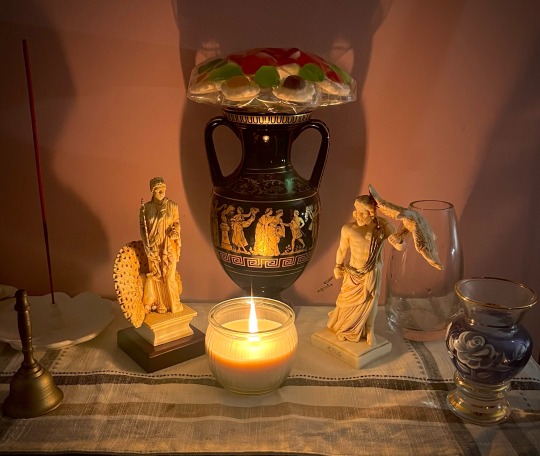
🌹 Theogamia Shrine 🌹
February 14th, 2024 (modern date I chose)
Happy Theogamia 💐
Today I'm celebrating the sacred marriage, hieros gamos, of King Zeus & Queen Hera. May their anniversary bring blessings to all of us.
Invoked as: Zeus Teleios & Zeus Herkeios and Hera Teleia & Hera Oikos.
The libation was water. The offering in the center is a bouquet of heart and flower shaped gummies my mother gave me. I didn't have the energy to offer the incense, but even just the stick smells nice.
#polytheism#paganism#helpol#hellenic polytheism#hellenic pagan#ofthetheoi#shrine#altar#hera deity#zeus deity#hera#zeus#theogamia#sacred marriage#helios gamos#festival#holiday#celebration day#izkurereshkigal altars
101 notes
·
View notes
Text
Near the end of Donald Trump’s first term, his top immigration adviser, Stephen Miller, encouraged Administration officials not to worry about federal judges who might get in their way. “Don’t waste time trying to anticipate the risk of litigation,” one official, summarizing Miller’s argument, told me at the time. “We’ll win at the Supreme Court.”
Earlier this week, when one of the Trump Administration’s most extreme immigration policies came before the Court, the Justices seemed to validate Miller’s strategy. But it was a strange, technical ruling that requires some context.
On March 14th, the President signed a proclamation to use the Alien Enemies Act—an eighteenth-century law invoked only three times before in U.S. history—as the basis for deporting Venezuelans to a mega-prison in El Salvador. Citing alarmingly flimsy evidence, the government claimed these individuals were members of a violent gang. The American Civil Liberties Union sued, and the same day a federal judge in Washington, D.C., issued an order blocking the deportations. Typically, the saga would halt there, as lawyers argued it out in court. But the Trump Administration made a shocking move: it deported two hundred and thirty-eight Venezuelans anyway.
On Monday, in a 5–4 decision, the Supreme Court ruled that the A.C.L.U. had brought its claims to the wrong court. According to the justices in the majority, the lawyers should have brought their case to a judge in Texas, where the deportees had been briefly detained. “This holding was, suffice it to say, not exactly obvious,” the legal scholar Steve Vladeck wrote. For one thing, the men in question were no longer in the United States. What could it possibly mean for them to seek relief now, in Texas? The Administration’s defiance of a federal judge went unaddressed. “The Government’s conduct in this litigation poses an extraordinary threat to the rule of law,” Justice Sonia Sotomayor wrote, in her dissent.
And yet, the Supreme Court hardly validated the Trump Administration’s position. The decision was explicit on one point: those who are detained under the Alien Enemies Act must be given a chance to defend themselves before they are deported. The A.C.L.U. have already brought new cases on behalf of Venezuelans who are detained in New York and Texas and face possible deportation to El Salvador. Two federal judges so far have issued orders blocking the government from deporting them.
But a horrifying question remains, one which neither the Supreme Court nor the Trump Administration seems interested in trying to answer. The men who are now stuck in a Salvadoran prison were sent there without due process. It’s been almost a month since they were deported. Their families and lawyers haven’t spoken to them. What will happen to them now?
Jonathan Blitzer, in the 4/11/25 New Yorker Daily Blitzer is a staff writer covering immigration and politics.
12 notes
·
View notes